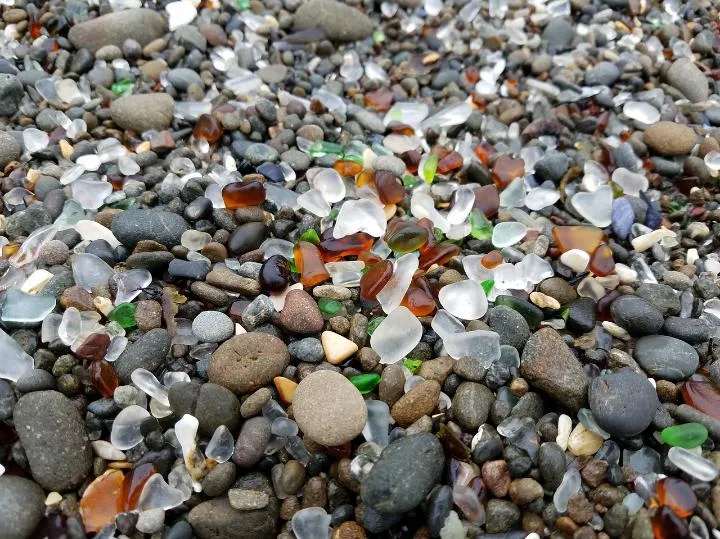Key Takeaways
- Beach in Fort Bragg, California, has an abundance of glass washed over by the ocean into smooth, gemlike pieces
- The seaglass is the result of the site once being a dump
- Though it’s hard to get to, it’s worth the extra trip
California has no shortage of natural wonders to explore, especially beautiful beaches. But, lovers of sea glass should be sure to check out the Golden State’s Glass Beach.
This Northern California beach in Fort Bragg lacks your average sand or pebbles. Instead, the shore is full of layers of gem-like sea glass.
What was formed from an old trash dumping site is now a tourist attraction for those looking for an out-of-the-ordinary excursion.
Collectors of sea glass should be forewarned that taking the glass is not allowed because the beach is part of MacKerricher State Park, and the state wants to preserve it for future visitors.
But it’s still a beautiful beach to spend some time at, sifting through sea glass and seeing what you can find, even if you can’t take a souvenir.
How Did All The Sea Glass Get To Glass Beach?
From 1906 to 1967, the site that is now Glass Beach used to be a trash dump. Dumping garbage over the cliffs into the water below was common in coastal communities like Fort Bragg, according to Mendocino County, where the beach is located.
Even cars and appliances were dumped there. But the glass from the objects thrown in the water—car headlights, soda bottles, food jars and more—eventually got weathered down by the ocean and broke up by hitting rocks on the shore.
Due to a process called hydration, saltwater took the lime and soda content out of the glass, which results in a pitted, or frosted appearance. Over time, the result was the frosted, smooth pieces of sea glass covering the shore of the beach.
The most common seaglass colours are white, brown, or emerald green. These are pieces formed from common glass objects like food jars or beer bottles. Different shades of greens and blues, like seafoam or aqua, are rarer and usually come from old medicine or cosmetic bottles.
Generally, the rarer the colour, the rarer the glass object it came from. Lavender, pink, turquoise, and teal, likely from objects like perfume bottles, are rare.
Because of the wide array of trash dumped in the water at Glass Beach, visitors may be able to find unique sea glass colours. Elusive ruby-red pieces likely came from the headlights of old cars, and sapphire pieces were likely formed from old medicine bottles.
Getting To Glass Beach
Fort Bragg is about 170 miles north of San Francisco and about 190 miles northwest of Sacramento, about a three-and-a-half-hour drive from either city. Glass Beach is located at the end of Fort Bragg’s Elm Street, where there is also parking.
You’ll find a path, the Glass Beach Trail, leading to the beach. There, you can take in the beauty of the beach, snap some Instagram-worthy photos, and search for unique pieces of sea glass. The cliffs and rocks overlooking the beach offer a beautiful view and a picnic spot.
There are technically three glass beaches, and Glass Beach #3 is the only one that is technically in MacKerricher State Park, at its southernmost end. The park is open from sunrise until 10 pm.
Visitors can follow trails south from Glass Beach #3 to reach Glass Beach #1 and #2.
Keep in mind that the weather in Fort Bragg can vary. The state park recommends wearing layers to keep yourself comfortable. The weather is generally mild, from mid-50-to-60 degrees Fahrenheit during the day, all year long.
Sights to check out near Glass Beach
Once you’ve explored Glass Beach and snapped some photos of the unique sea glass you found (and then put them back), there’s more to explore in MacKerricher State Park and the surrounding area.
From Glass Beach, visitors can follow another trail north, crossing over a train trestle to Pudding Creek Beach. This beach has walking paths with beautiful views, tiny coves, and tidal pools to explore.
The rest of MacKerricher State Park offers various activities for visitors. It has diverse ecosystems, from dunes to forests and beaches to wetlands. The park stretches along nearly 9 miles of the coast. There are trails for hiking, jogging, bicycling, horseback riding, and campgrounds for people to spend the night.
It is also a popular site for whale watching in winter and spring, and visitors can spot seals along the coast. Dogs are also welcome, but they must be on a leash.
 If you haven’t had your fill of sea glass by the time you leave Glass Beach, the International Sea Glass Museum, located on Highway 1 south of downtown Fort Bragg, promotes itself as the largest sea glass museum in the world. It has more than 3,000 pieces of sea glass and jewelry created from it, as well as some pieces recovered from the sea.
If you haven’t had your fill of sea glass by the time you leave Glass Beach, the International Sea Glass Museum, located on Highway 1 south of downtown Fort Bragg, promotes itself as the largest sea glass museum in the world. It has more than 3,000 pieces of sea glass and jewelry created from it, as well as some pieces recovered from the sea.
Cass Farrington, a retired sea captain, founded it. Visitors can learn more about the history of sea glass and admire the collection.
Fort Bragg has a population of about 7,300 people and has various dining and lodging options, from larger chains like Denny’s and Starbucks to mom-and-pop restaurants and cafes. Other attractions in the area include Mendocino Coast Botanical Gardens, Russian Gulch State Park, and Noyo Harbor, which can be a great base for doing water-based activities like kayaking or whale watching
